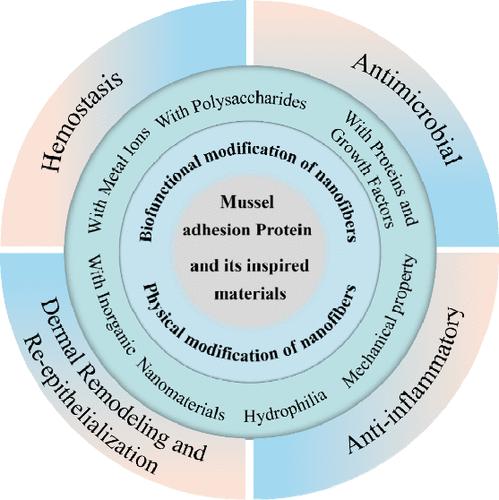Advances in Mussel Adhesion Proteins and Mussel-Inspired Material Electrospun Nanofibers for Their Application in Wound Repair
IF 5.4
2区 医学
Q2 MATERIALS SCIENCE, BIOMATERIALS
引用次数: 0
Abstract
Mussel refers to a marine organism with strong adhesive properties, and it secretes mussel adhesion protein (MAP). The most vital feature of MAP is the abundance of the 3,4-dihydroxyphenylalanine (DOPA) group and lysine, which have antimicrobial, anti-inflammatory, antioxidant, and cell adhesion-promoting properties and can accelerate wound healing. Polydopamine (PDA) is currently the most widely used mussel-inspired material characterized by good adhesion, biocompatibility, and biodegradability. It can mediate various interactions to form functional coatings on cell-material surfaces. Nanofibers based on MAP and mussel-inspired materials have been exerting a vital role in wound repair, while there is no comprehensive review presenting them. This Review introduces the structure of MAPs and their adhesion mechanisms and mussel-inspired materials. Second, it introduces the functionalized modification of MAPs and their inspired materials in electrospun nanofibers and application in wound repair. Finally, the future development direction and coping strategies of MAP and mussel-inspired materials are discussed. Moreover, this Review can offer novel strategies for the application of nanofibers in wound repair and bring about new breakthroughs and innovations in tissue engineering and regenerative medicine.

贻贝粘附蛋白和贻贝启发材料电纺纳米纤维在伤口修复中应用的研究进展
贻贝是一种海洋生物,具有很强的粘附性,能分泌贻贝粘附蛋白(MAP)。MAP 的最大特点是含有大量 3,4-二羟基苯丙氨酸(DOPA)基团和赖氨酸,具有抗菌、消炎、抗氧化和促进细胞粘附的特性,可加速伤口愈合。聚多巴胺(PDA)是目前应用最广泛的贻贝启发材料,具有良好的粘附性、生物相容性和生物降解性。它可以介导各种相互作用,在细胞材料表面形成功能涂层。基于 MAP 和贻贝启发材料的纳米纤维在伤口修复中发挥着重要作用,但目前还没有全面介绍这些材料的综述。本综述介绍了 MAP 的结构及其粘附机制和贻贝启发材料。其次,介绍了 MAPs 及其启发材料在电纺纳米纤维中的功能化改性以及在伤口修复中的应用。最后,讨论了 MAP 及其启发材料的未来发展方向和应对策略。此外,本综述还能为纳米纤维在伤口修复中的应用提供新的策略,为组织工程和再生医学带来新的突破和创新。
本文章由计算机程序翻译,如有差异,请以英文原文为准。
求助全文
约1分钟内获得全文
求助全文
来源期刊

ACS Biomaterials Science & Engineering
Materials Science-Biomaterials
CiteScore
10.30
自引率
3.40%
发文量
413
期刊介绍:
ACS Biomaterials Science & Engineering is the leading journal in the field of biomaterials, serving as an international forum for publishing cutting-edge research and innovative ideas on a broad range of topics:
Applications and Health – implantable tissues and devices, prosthesis, health risks, toxicology
Bio-interactions and Bio-compatibility – material-biology interactions, chemical/morphological/structural communication, mechanobiology, signaling and biological responses, immuno-engineering, calcification, coatings, corrosion and degradation of biomaterials and devices, biophysical regulation of cell functions
Characterization, Synthesis, and Modification – new biomaterials, bioinspired and biomimetic approaches to biomaterials, exploiting structural hierarchy and architectural control, combinatorial strategies for biomaterials discovery, genetic biomaterials design, synthetic biology, new composite systems, bionics, polymer synthesis
Controlled Release and Delivery Systems – biomaterial-based drug and gene delivery, bio-responsive delivery of regulatory molecules, pharmaceutical engineering
Healthcare Advances – clinical translation, regulatory issues, patient safety, emerging trends
Imaging and Diagnostics – imaging agents and probes, theranostics, biosensors, monitoring
Manufacturing and Technology – 3D printing, inks, organ-on-a-chip, bioreactor/perfusion systems, microdevices, BioMEMS, optics and electronics interfaces with biomaterials, systems integration
Modeling and Informatics Tools – scaling methods to guide biomaterial design, predictive algorithms for structure-function, biomechanics, integrating bioinformatics with biomaterials discovery, metabolomics in the context of biomaterials
Tissue Engineering and Regenerative Medicine – basic and applied studies, cell therapies, scaffolds, vascularization, bioartificial organs, transplantation and functionality, cellular agriculture
 求助内容:
求助内容: 应助结果提醒方式:
应助结果提醒方式:


